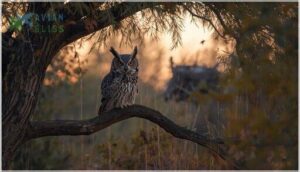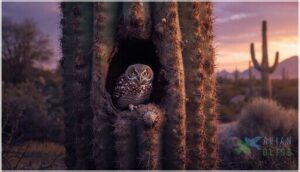This site is supported by our readers. We may earn a commission, at no cost to you, if you purchase through links.

When the sun dips below Arizona’s saguaro-studded horizons, a different world wakes up. Thirteen species of owls call this state home, from the tiny Elf Owl—barely larger than a sparrow—nesting in woodpecker holes, to the fierce Great Horned Owl perched in suburban parks.
Arizona’s dramatic elevation changes create a stacking effect of habitats: desert grasslands shelter Burrowing Owls in abandoned ground squirrel burrows, while mountain forests host the federally threatened Mexican Spotted Owl in shaded canyons.
Whether you’re hearing an unfamiliar trill from your backyard mesquite or spotting heart-shaped faces hunting over farmland at dusk, you’re encountering one of North America’s most diverse owl communities.
Table Of Contents
- Key Takeaways
- Types of Owls Found in Arizona
- Owl Habitats and Distribution in Arizona
- Identifying Arizona Owls by Features
- Behavior, Diet, and Ecological Roles
- Top Owl Identification and Reference Guides
- Frequently Asked Questions (FAQs)
- How many owl species are there in Arizona?
- Where do owls live in Arizona?
- Are there pygmy owls in Arizona?
- Are horned owls common in Arizona?
- What kind of owl lives in Arizona?
- Is it good to have an owl in your yard?
- Why are owls hanging around my house?
- Why attract owls to your yard?
- What do owls in Arizona eat?
- How long do Arizona owls typically live?
- Conclusion
Key Takeaways
- Arizona hosts thirteen owl species across dramatically different elevations and habitats, from desert-dwelling Elf Owls nesting in saguaro cacti to federally threatened Mexican Spotted Owls in mountain forests, making it one of North America’s most diverse owl communities.
- Habitat loss from urbanization, agricultural conversion, and climate change threatens multiple species—particularly the Ferruginous Pygmy Owl with fewer than 100 individuals remaining and the Flammulated Owl facing potential loss of 85% of suitable habitat over 70 years.
- You can identify Arizona’s owls through distinctive combinations of size, facial disk shape, eye color, ear tufts, and vocalizations, with features like heart-shaped faces in Barn Owls or the bouncing-ball trill of Western Screech-Owls serving as reliable field marks.
- These owls play critical ecosystem roles as natural pest controllers—Barn Owls alone consume more rodent pests than any other animal group—while also regulating wildlife populations and serving as indicators of habitat health across Arizona’s changing landscapes.
Types of Owls Found in Arizona
Arizona’s diverse landscapes support thirteen distinct owl species, each adapted to different habitats across the state. You’ll find everything from the tiny Elf Owl, barely bigger than a sparrow, to the formidable Great Horned Owl that rules the night skies.
Here’s what you can expect to encounter in Arizona’s deserts, forests, and grasslands.
Great Horned Owl
You’ll spot the Great Horned Owl across every Arizona habitat, from cactus-studded deserts to city parks. This dominant predator weighs up to 88 ounces and stretches nearly 25 inches long, making it Arizona’s most common large owl species.
With 5.7 million individuals across North America, you’re looking at striking urban adaptation and dietary diversity—they’ll hunt everything from jackrabbits to tarantulas. Their distinctive features include prominent ear tufts.
Barn Owl
While the Great Horned Owl dominates with size, you’ll recognize the Barn Owl by its ghostly white, heart-shaped face and silent flight.
This medium-sized species thrives in Arizona’s open grasslands and agricultural areas, where hunting efficiency peaks—98% of their diet consists of rodents. Their urban adaptation has made them invaluable for natural rodent control, particularly in Maricopa and Pima counties.
There, nest boxes support stable populations. They readily use nest boxes, which are effective in attracting barn owls.
Burrowing Owl
Unlike barn owls that occupy buildings, Burrowing Owls in Arizona nest underground in open grasslands and agricultural fields. You’ll spot these sandy-colored, long-legged birds standing near burrows across southern Arizona, though habitat loss from urbanization has triggered steady population declines.
Conservation efforts include artificial burrow installations and relocation programs. Their diet patterns shift seasonally—insects dominate summer months, while small mammals sustain them year-round.
Western Screech-Owl
Measuring around 8 to 10 inches, the Western Screech-Owl thrives in Arizona’s mesquite woodlands and suburban parks year-round, with about 180,000 individuals statewide. You’ll recognize this gray-brown owl by its yellow eyes and short ear tufts. Desert adaptations include bristled feet suited for arid climates.
Its bouncing-ball trill distinguishes it from similar species, while sit-and-wait hunting targets rodents and insects.
Whiskered Screech-Owl
You’ll find the Whiskered Screech-Owl almost exclusively in southeastern Arizona’s mountain woodlands, where habitat conservation maintains around 2,500 breeding pairs. This 6-to-8-inch owl species identification centers on extra-large yellow eyes and prominent ear tufts.
Vocal communication involves rhythmic morse-code-like toots, distinct from other owls in Arizona.
Nesting success depends on natural tree cavities at elevations between 3,300 and 9,500 feet, where prey diversity—insects, small mammals, and lizards—sustains its sit-and-wait hunting strategy.
Long-eared Owl
You’ll recognize the Long-eared Owl by those signature ear tufts positioned close together—a slender, crow-sized species facing habitat loss across Arizona’s woodlands. Owl species identification relies on its cryptic plumage and deep hooting calls.
Nesting habits involve recycling old corvid stick nests in dense trees, while hunting skills target rodents over grasslands at night.
Conservation status remains stable globally, though dietary needs and owl habitats depend on intact riparian zones and prey availability.
Short-eared Owl
You’ll spot the Short-eared Owl hunting over open grasslands during daylight—an uncommon winter visitor among owls in Arizona. Owl species identification features include buoyant, moth-like flight and pale plumage.
Its diet composition centers on voles and mice in suitable owl habitats and ranges.
Arizona status reflects habitat loss from agricultural conversion, prompting conservation efforts to protect remaining grassland ecosystems where this short-eared owl forages.
Northern Saw-whet Owl
You’ll recognize the Northern Saw-whet Owl by its cat-like face and striking yellow eyes—a tiny forest dweller measuring just 6.7 to 8.7 inches. This small owl species in Arizona favors mixed coniferous forests with dense thickets.
Prey preference includes deer mice and voles, hunted nightly. Saw-whet migration brings individuals from as far as British Columbia, making population monitoring necessary for forest conservation efforts statewide.
Elf Owl
The Elf Owl stands as North America’s smallest owl species, measuring just 5 to 6 inches—hardly larger than a sparrow. This insectivore diet specialist is found throughout Arizona’s Sonoran Desert from late March through early July, nesting in saguaro cavities created by woodpeckers.
Arizona hosts up to 45% of the global breeding population, making conservation challenges particularly significant. Habitat loss threatens nesting cavities and desert adaptation zones statewide.
Arizona shelters nearly half the world’s breeding Elf Owls, yet habitat loss threatens the nesting cavities they depend on
Northern Pygmy Owl
You’ll find the Northern Pygmy Owl defying typical owl behavior—it hunts during daylight hours, perching quietly before ambushing birds and small mammals.
Fewer than 30 individuals are documented annually in Arizona, reflecting severe population decline driven by habitat loss in mesquite woodlands and saguaro forests.
Breeding success depends heavily on cavity availability in mature cacti, making conservation efforts critical for this diurnal hunter.
Ferruginous Pygmy Owl
The cactus ferruginous pygmy owl faces even steeper challenges in Arizona, with fewer than 100 individuals remaining in isolated pockets of the Sonoran Desert.
Population decline stems from habitat loss—urban sprawl and groundwater withdrawal fragment nesting sites along xeroriparian washes.
Conservation efforts now focus on protecting cavity-rich saguaro stands, where these diurnal hunters capture reptiles, birds, and insects from elevated perches near dawn and dusk.
Flammulated Owl
Flammulated Owls favor Arizona’s montane forests along the Mogollon Rim, hunting moths from ponderosa pine perches after dark. You’ll recognize this migratory species by its insect-based diet and reliance on woodpecker-carved nesting cavities in mature trees.
Climate impacts threaten 85% of suitable habitat over the next 70 years, earning it Tier 2 conservation status as forest management struggles to preserve the mixed-age structure these owls need.
Mexican Spotted Owl
Among owls in Arizona, the Mexican Spotted Owl stands apart as a federally threatened species, with only 2,100 individuals north of Mexico. Habitat loss from logging and wildfire has devastated populations—some areas saw 10% annual declines through the 1990s.
You’ll find these woodrat specialists in mature ponderosa pine forests and shady canyons, where survival rates hover around 81% for territorial adults.
Owl Habitats and Distribution in Arizona
Arizona’s diverse landscape nurtures owls across a surprising range of environments, from scorching deserts to cool mountain forests. Each species has carved out its own niche, whether that’s nesting in a saguaro cactus, burrowing underground, or thriving in your neighborhood park.
Let’s look at where you’re most likely to encounter these birds across the state.
Desert and Grassland Habitats
You’ll find at least seven owl species thriving in Arizona’s desert habitats and grasslands, where arid owl species like the Burrowing Owl, Elf Owl, and Ferruginous Pygmy-Owl have adapted to sparse vegetation.
Nesting site selection depends on existing burrows and saguaro cavities, but population decline causes like urban sprawl threaten these areas.
Desert prey resources remain abundant, though conservation significance grows as habitats shrink statewide.
Forest and Mountain Ranges
Above 3,700 feet, Arizona’s mountain forests and woodland habitats shelter some of the state’s most specialized owls. Elevation patterns shape where you’ll encounter species like the Mexican Spotted Owl, Northern Saw-whet Owl, and Flammulated Owl, though population trends show concerning habitat changes ahead.
Key ranges supporting forest owls include:
- Mogollon Rim and White Mountains: Mixed conifer forests with Douglas fir and ponderosa pine
- Sky Island mountain ranges: Madrean pine-oak woodlands in southeastern Arizona
- Central ponderosa pine forests: Primary breeding grounds above 5,000 feet
- Subalpine zones: Higher elevation forests harboring Long-eared Owls
- Steep canyon systems: Old-growth forests where Mexican Spotted Owls nest
Urban and Suburban Environments
Across Phoenix and Tucson, you’ll spot owls in Arizona adapting to urban areas with surprising success. Great Horned Owls nest in city parks, while Barn Owls colonize bridges and manmade structures.
Burrowing Owls face habitat loss impacts from development, prompting conservation initiatives including artificial burrows and relocation programs.
Over 112 suburban nests were monitored recently, though rapid urbanization continues displacing populations despite these protective efforts.
Cactus and Burrow Nesting Sites
In Arizona’s deserts and canyons, you’ll discover owls nesting in unexpected places. Saguaro cacti host Elf Owls and cactus ferruginous pygmy-owls in cavities carved by woodpeckers, with roughly 79% of pygmy-owl territories utilizing these towering plants.
Burrowing Owls select underground burrows dug by mammals, though habitat threats from invasive buffelgrass and development continue reducing nesting sites.
Conservation efforts now include predator control and burrow monitoring during nesting season.
Seasonal and Year-Round Ranges
You’ll find most owls in Arizona are year-round residents, including Great Horned, Barn, and Western Screech-Owls, which maintain stable populations across diverse elevational ranges. However, migration patterns vary: Burrowing Owls in northern areas depart by mid-October, while Short-eared Owls arrive as seasonal visitors during cooler months.
Habitat variation and range shifts affect species like Ferruginous Pygmy-Owls, whose declining abundance highlights conservation impacts on non-breeding range stability.
Identifying Arizona Owls by Features
When you’re trying to identify an owl in Arizona, knowing what to look for makes all the difference. Each species has distinct physical traits and vocalizations that set it apart from the rest.
Here’s how to recognize Arizona’s owls by their key identifying features.
Size and Plumage Characteristics
You can identify Arizona owls by physical traits that vary considerably across species. Size dimorphism exists in most species, with females usually heavier than males. Owl physical characteristics worth noting include:
- Great Horned Owls reach 25 inches with barred brown-gray plumage
- Barn Owls span 17 inches with white facial disks
- Elf Owls measure just 5.5 inches with mottled brown feathers
- Western Screech-Owls display gray-brown streaked patterns
Feather adaptations and regional variations affect plumage camouflage effectiveness.
Facial Disk and Eye Color
You’ll notice facial disks and eye colors vary dramatically across Arizona owl species, serving as key identification markers. The disk shape channels sound to asymmetrical ears, enhancing auditory adaptations for hunting. Eye pigmentation reveals activity patterns: dark eyes indicate nocturnal habits, while yellow eyes suggest diurnal behavior, improving visual acuity in bright conditions.
| Owl Species | Disk Shape | Eye Color | Activity Pattern | Habitat Correlation |
|---|---|---|---|---|
| Barn Owl | Heart-shaped | Dark brown/black | Nocturnal | Open grasslands |
| Great Horned Owl | Round, 120mm diameter | Yellow | Crepuscular | Forests, deserts, urban |
| Northern Saw-whet Owl | Round | Yellow | Nocturnal | Dense thickets |
| Burrowing Owl | Flattened | Yellow | Diurnal/Crepuscular | Agricultural fields |
| Western Screech-Owl | Round | Yellow | Nocturnal | Open woodlands, urban |
These features in your owl identification guide help distinguish species quickly, with disk size correlating to hunting strategy and eye characteristics reflecting environmental adaptations across diverse Arizona habitats.
Ear Tufts and Camouflage
Beyond facial features, ear tufts provide critical clues for owl identification in Arizona. Great Horned Owls display prominent tufts up to 50 millimeters tall, while Western Screech-Owls show shorter 15–20 millimeter versions. These structures serve as tuft camouflage mechanisms, mimicking twigs when raised.
Plumage crypsis strategies improve concealment through mottled patterns. Behavioral concealment includes elongated postures during threats.
Tufted species gain ecological advantages, achieving 40% better roosting survival in woodland habitats through improved feather patterns and camouflage.
Distinctive Calls and Vocalizations
While visual cues help during daylight, owl vocalizations and sounds often provide your best identification tool after dark. Great Horned Owls produce deep hoots audible several kilometers away, functioning in territory defense. Mexican Spotted Owls average 10-minute calling bouts with distinct species dialects. Burrowing Owl juveniles mimic rattlesnakes through buzzing juvenile calls—an extraordinary acoustic adaptation.
Vocalization patterns vary by season, with call function shifting between mate attraction and alarm responses.
Behavior, Diet, and Ecological Roles
Understanding how Arizona’s owls behave and what they eat reveals their important place in the state’s ecosystems. Most species are nocturnal hunters, but a few break the mold by being active during daylight hours.
Here’s what you need to know about their hunting styles, nesting habits, and ecological impact.
Nocturnal Vs. Diurnal Activity
Most Arizona owls are nocturnal, meaning they’re active from dusk through early morning when hunting adaptations like enhanced sensory biology give them an edge. You’ll spot Great Horned Owls and Barn Owls most often during these hours.
However, Burrowing Owls break the pattern as diurnal species, hunting during daylight across Arizona’s open deserts.
Seasonal shifts and habitat influence also affect when you’ll observe these birds, with sleep patterns reversing between nocturnal and diurnal owl behavior.
Hunting Techniques and Prey
When night falls, you’ll witness Arizona owls using Silent Flight and Perch Hunting techniques to capture prey. Their Sensory Adaptations—keen eyesight, remarkable hearing, and facial discs—help them detect rodents, insects, and small birds in darkness. Habitat Adaptation shapes their methods:
- Desert species glide silently to locate prey beneath sand
- Forest owls scan from perches for terrestrial mammals
- Great Horned Owls tackle over 200 mammal species
- Barn Owls swallow voles whole
- Eastern Screech-Owls achieve 56% Capture Success rates
Their diverse diet sustains Arizona ecosystems.
Nesting and Breeding Behaviors
During breeding season, you’ll find Arizona owl populations using creative nesting sites—Great Horned Owls commandeer old hawk nests, while Western Screech-Owls favor saguaro cactus cavities.
Nest site selection peaks mid-February through early summer, with clutch sizes averaging 2.5 eggs for larger species.
Parental behavior includes dedicated incubation and brooding, achieving roughly 56-70% nesting success across studied breeding populations despite environmental pressures and predation risks.
Role in Arizona Ecosystems
Beyond hunting prey, you’ll recognize owls as ecosystem engineers shaping Arizona’s wildlife communities in measurable ways:
- Pest control: Barn Owls remove more rodent pests than any other animal group, reducing agricultural damage and pesticide reliance.
- Trophic dynamics: Great Horned Owls regulate populations from insects to mammals.
- Climate adaptation: Genetic diversity in peripheral populations enhances species resilience.
- Conservation value: Protected populations sustain biodiversity across changing habitats.
Top Owl Identification and Reference Guides
If you’re serious about identifying owls in Arizona, you’ll want reliable field guides that show what to look for. The right reference can help you sort out similar species like the Western and Whiskered Screech-Owls or distinguish juvenile birds from adults.
Here are four excellent resources to keep on hand during your next birding outing.
1. North American Owl Reference Guide
If you’re serious about owl identification beyond Arizona, the Peterson Reference Guide to Owls of North America and the Caribbean is your go-to utility guide. This research-backed resource covers 39 species with nearly 400 photographs documenting plumage variations, behaviors, and habitat contexts.
Each species account includes a detailed content structure—measurements, vocalizations, range maps, and conservation status. The distinctive features here are subspecies maps and 86 downloadable calls from the Macaulay Library, giving you both visual and audio identification tips for thorough bird identification across diverse owl species.
2. Owls Of North America Guide
You’ll find the Owls Of North America Guide stands out for its Species Coverage—documenting all 39 owl species across Canada, the U.S., Mexico, and the Caribbean with Research Basis grounded in ornithological studies and banding data.
Visual Presentation includes nearly 400 photographs showing Identification Features like plumage, facial disks, and eye color variations.
Each Arizona owl species you encounter receives detailed treatment, from owl calls (with 86 recordings) to Conservation Insights backed by field research and monitoring programs for accurate owl identification.
3. Eastern North America Owl Poster
The Eastern North America Owl Poster delivers museum-grade print quality with fade-resistant inks and species illustrations by David Allen Sibley, offering identification accuracy through multiple visual perspectives of all 13 regional owl species.
While its distribution scope centers on eastern ranges—from Florida to Ontario—you’ll appreciate its educational utility for comparing facial disk shapes, eye color, and plumage patterns that inform your Arizona owl identification skills.
The 19″ × 27″ format presents scientific names, wingspans, and conservation data that support both classroom learning and field reference needs.
4. Western North America Owl Poster
The Western North America Owl Poster illustrations cover 10 regularly occurring species, including the Ferruginous Pygmy Owl confirmed in southern Arizona and the Northern Saw-whet Owl found in montane forests.
It provides species identification through plumage details, facial disk patterns, and ear tuft shapes. Available in 12″ × 18″ and 24″ × 36″ formats, it displays habitat ranges, conservation status data, and scientific nomenclature.
This supports both educational uses in classrooms and field identification of Arizona owls by their distinctive calls and physical characteristics.
Frequently Asked Questions (FAQs)
How many owl species are there in Arizona?
You’ll encounter 13 regularly occurring owl species across Arizona’s diverse landscapes as of
These bird species represent over 20% of all owl species native to the continental United States, making Arizona a hotspot for owl diversity.
Where do owls live in Arizona?
Arizona’s owls occupy diverse habitats—deserts, forests, mountains, canyons, and grasslands.
Urban adaptation allows some species to thrive near cities, while conservation efforts address habitat loss.
Nesting preferences vary, influenced by prey availability across these ecosystems.
Are there pygmy owls in Arizona?
Yes, you’ll find two pygmy owl species in Arizona: the Northern Pygmy Owl in higher elevation forests and the critically threatened Ferruginous Pygmy Owl in Sonoran desert habitats near Tucson.
Are horned owls common in Arizona?
Great Horned Owl populations remain stable throughout the state, with an estimated 7 million across North America.
You’ll find these year-round residents thriving in diverse habitats, from urban neighborhoods to remote wilderness areas.
What kind of owl lives in Arizona?
You’ll find thirteen owl species across the state, ranging from the tiny Elf Owl to the massive Great Horned Owl.
Regional populations vary widely, reflecting Arizona’s diverse habitats and impressive nocturnal bird diversity.
Is it good to have an owl in your yard?
Having owls in your yard offers natural pest control, aids biodiversity, and signals ecosystem health.
However, be aware of potential risks from secondary poisoning through rodenticides and the legal protections owls receive in Arizona.
Why are owls hanging around my house?
Your yard likely offers abundant prey like rodents and insects drawn to landscaping and water sources. Perching spots on walls or power lines, plus artificial nests, create ideal owl habitats in urban Arizona.
Why attract owls to your yard?
You’ll see fewer rodents damaging your garden without chemicals. Pest control becomes natural, cost savings add up, and nest boxes support biodiversity boost while strengthening conservation impact across Arizona’s owl habitat.
What do owls in Arizona eat?
Over 90% of their diet consists of small mammals, insects, reptiles, and birds. Great Horned Owls alone prey on more than 200 mammal species, while Barn Owls consume mostly rodents.
How long do Arizona owls typically live?
Lifespan varies widely among Arizona’s owl species, ranging from 3–6 years for tiny Elf Owls to 8–13 years for Great Horned Owls.
Rodenticide poisoning and predation impact survival, while captive longevity often exceeds wild lifespans.
Conclusion
You could spend a lifetime walking Arizona’s trails and still discover something new about its owls in Arizona—each canyon, creekbed, and saguaro stand holds different species adapted to remarkably specific niches.
From the Elf Owl’s cricket hunts to the Mexican Spotted Owl’s silent forest patrols, these thirteen species reveal how elevation, habitat, and behavior intertwine.
Your next evening hike might just introduce you to the trill, hoot, or screech you’ve been waiting to hear.



















